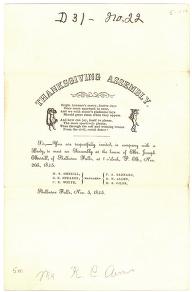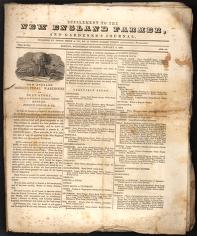|

Letter to Agnes Higginson from George Fuller

Pitted stone

"Thanksgiving Assembly"

List of plants in the garden of William Stoddard Williams

Harvesting Vine Ripened Cape Cod Cranberries

"Supplement to the New England Farmer, and Gardener's Journal"
|
Summary and Objective
Students will understand that cranberries were first used by Native Americans as a food, fabric dye and healing agent. Students will begin to develop an understanding for the commercial development of an item . Students will understand that time lines help us to put historical information (now and long ago) into a chronological order.Students will explore a classroom time line and, with the teacher, organize known and newly acquired information on to the time line.
Teaching Plan
Step 1.
Pre-activity 1-Ways we organize time-
Ask Students and explore:
How do we organize our time? (clock, timers)
How do we organize our school day? (class schedule)
How do we organize our week? (classroom calendar)
How do we organize our school year? (school/home calendars)
Today we will look at a way to organize many years.
Step 2.
Pre-activity 2-Introduce classroom time line.(suggestion: display permanent time line across wall (above bulletin/white boards, to be used throughout the year)Review groups of 10's using math tools (flats, longs, cubes). Ask students how many ones are in ten?How many tens are in a hundred? Demonstrate to students that the time line can be organized in groups of hundreds (1600,1700,etc.)and those 100's can be organized in groups of 10's (1810,1820,1830, etc.).And within each group of ten there are ten ones. (2001, 2002,etc.)Point out that the arrows show that time goes further back than our line shows and goes further on, into the future.
Step 3.
Pre-activity 3- With student input,add icons to the time line indicating NOW (students are in ____ grade), a short time ago (general birth years of students). Add icons for general years of parent's births, grandparent's births. Blank cards can be available to add "other times, other places" of interest to students and/or generate a list of "other times, places" to research for placement on time line.Today we will consider some things from long ago.
Step 4.
Introduce focus item: can of cranberry sauce
Generate a list of what the item is, what it is made out of, when/how it is used.(Display raw and dried cranberries as needed.)
Confirm: Yes, this is a can of cranberry sauce made out of cranberries (display a bag/bowl of whole cranberries, and dried berries).
Step 5.
Acknowledge the use of cranberries at our Thanksgiving dinners. At Thanksgiving we remember the harvest meal shared between the Pilgrims and the Native People, the Wampanoags.Put an icon on the time line for the arrival of the Pilgrims in 1620 and note the touch winter conditions that followed, adding an icon for 1621's harvest gathering.("How do we know what was eaten at the harvest meal?"Introduce primary resource from Plimoth web site, emphasizing the importance of primary resources. With students,highlight food items mentioned.) Although cranberries are not mentioned, we know Native Americans shared their knowledge of local foods with the Pilgrims. Cranberries were used by Native Americans for hundreds of years before the arrival of the Pilgrims (point to the left arrow on the time line) as a food, fabric dye and for healing. (Introduce Pitted Stone image from digital collection. "How do you think Native Americans used this tool?" To crush berries with dried deer meat and melted fat to make pemmican- a food that kept for a very long time.) Cranberry poultices were used to draw poison from arrow wounds. And the red dye was used to make rugs and blankets. European settlers adopted the Native American uses for the fruit and found the berry a valuable bartering tool.(Introduce crane/cranberry flower image from web site,"This is a cranberry flower. What animal does it look like to you?" The name "cranberry" derives from the Pilgrim name for the fruit, "craneberry", so called because the small, pink blossoms that appear in the spring resemble the head and bill of a Sandhill crane.)
Step 6.
Note that the Pilgrims did not call their harvest gathering, "Thanksgiving".Harvest festivals and days of giving thanks were celebrated throughout the year by early Americans. George Washington issued the first national Thanksgiving proclamation in 1789 (point to time line)and there were regional celebrations throughout the country. (When was this invitation to a Thanksgiving assembly used? Share "Thanksgiving Assembly" from digital collection and point to date on time line), but Thanksgiving did not become a national holiday until 1863, when President Abraham Lincoln proclaimed that an annual Thanksgiving Day would be observed the last Thursday of each November.Place icon on time line. Mark Revolutionary War/Civil War if these come into classroom conversation. You may let students know that you will be talking more about early American times throughout the year.Presidents still make Thanksgiving proclamations today (When was this proclamation made? Share Barack Obama's 2009 Thanksgiving Proclamation from Pilgrim Hall web site)
Step 7.
Bring focus back to the can of cranberry sauce. Cranberries are one of three fruits native to North America (along with blueberries and Concord grapes). Some farmers and scientists began experimenting with transplanted cranberry plants in the early 1800s. (Can you find cranberries mentioned in these primary documents? Share:"List of plants in the garden of William Stoddard Williams","Supplement to the New England Farmer and Gardener's Journal","Letter to Agnes Higginson from George Fuller" ,from digital collection).People experimented and larger crops were grown.Agriculture was important to the economy. In 1863 the U. S. Department of Agriculture created Massachusetts Agricultural College (University of Massachusetts). Point to time line (note this is the same year that Lincoln proclaimed Thanksgiving a national holiday).Farmers formed associations and found markets for their products.(What are the people doing in this picture? Display,"Harvesting Vine Ripened Cape Cod Cranberries" from digital collection. Eventually large businesses were formed such as Ocean Spray Cranberries, Inc. (formed as a grower owned marketing cooperative.)And we can buy cranberries in grocery stores today.Bring focus back to can of cranberry sauce.
Step 8.
Whew! Hold up one cranberry. From one small berry we have been able to talk about things that happen Now and Long Ago. Everything has a story and we can use our time line throughout the year as we talk about many things, people, and historical events.
|




